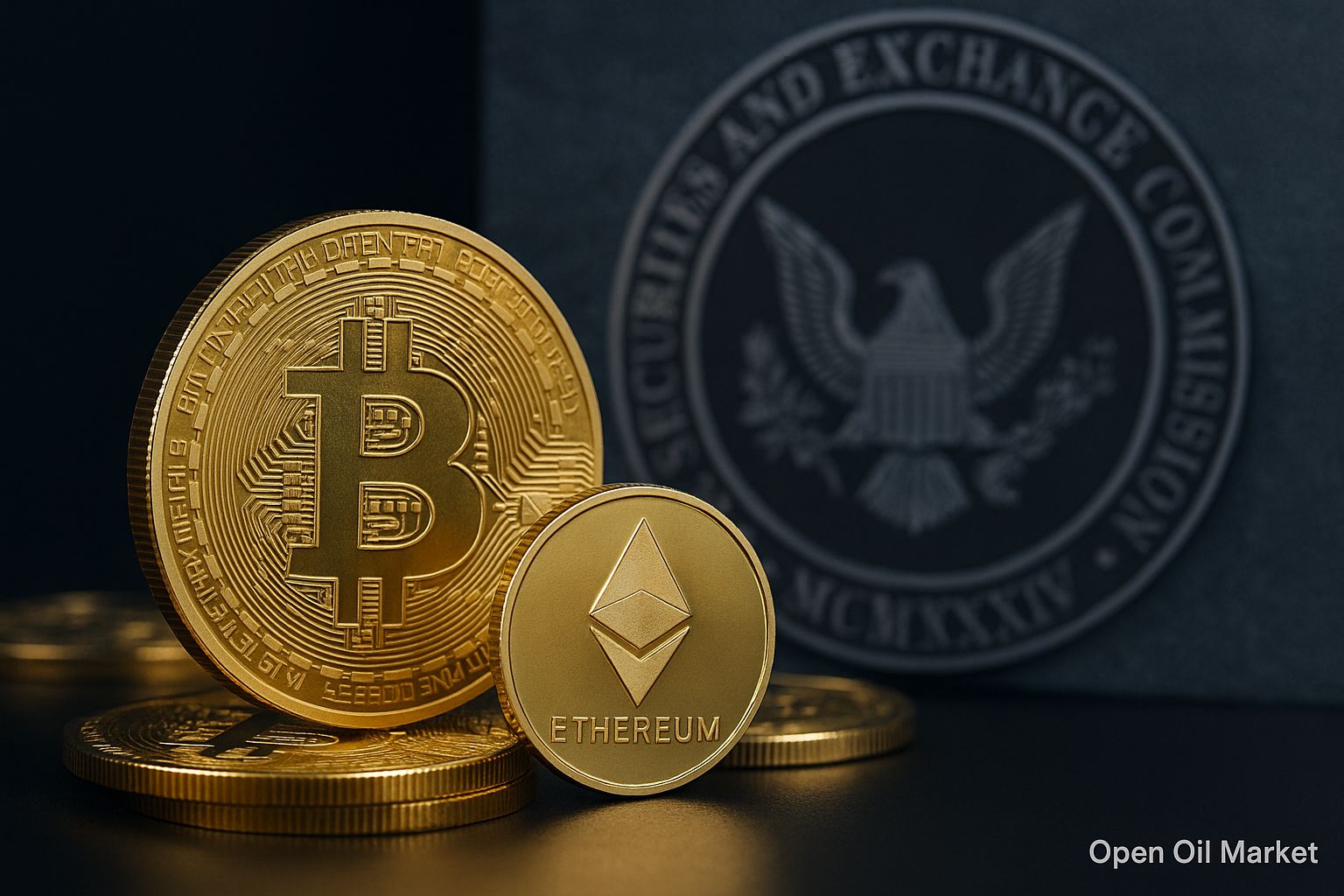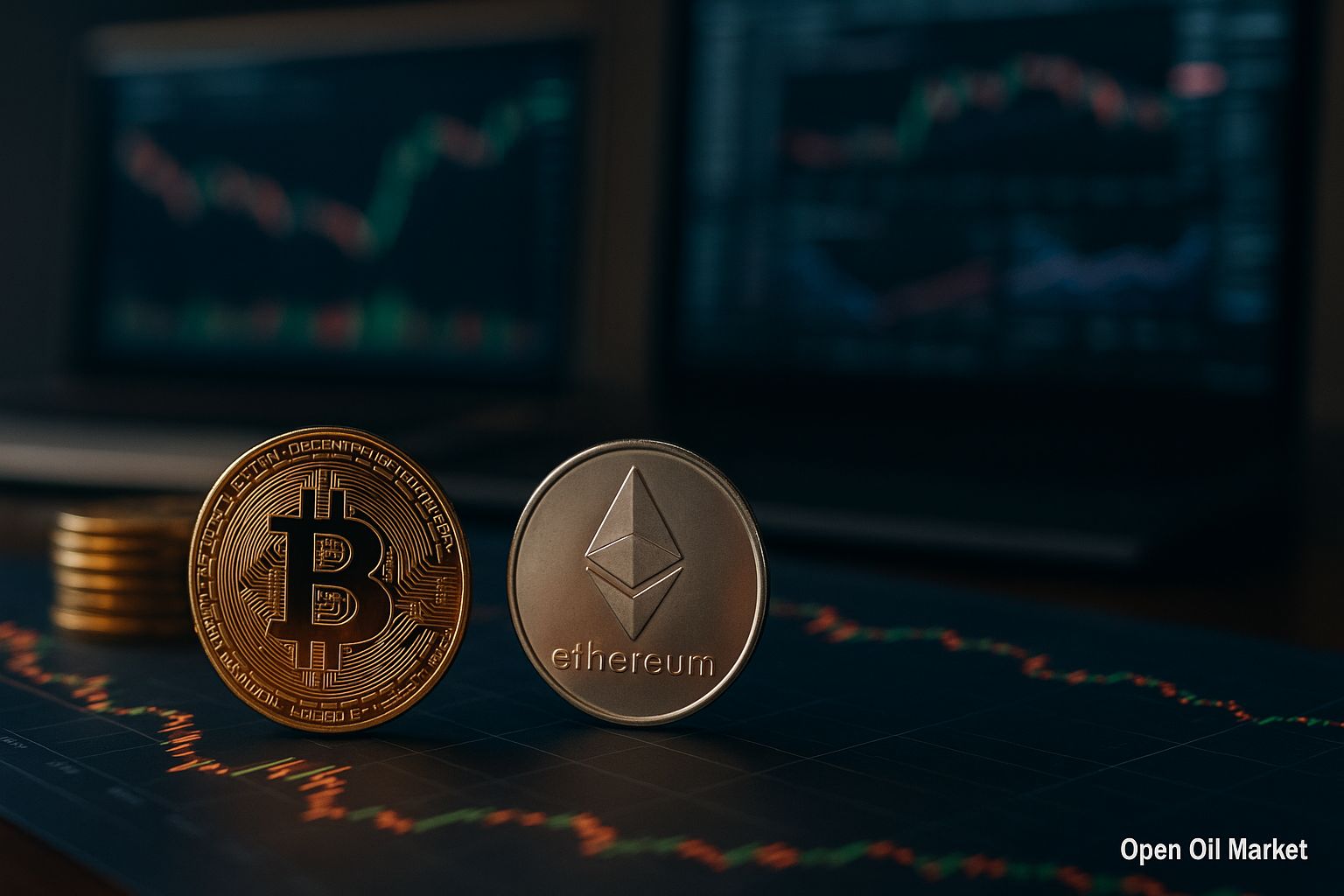
Cryptocurrency News, Wednesday, August 6, 2025 — The Market Consolidates; Visa and PayPal Bet on Cryptocurrencies
The cryptocurrency market remains resilient amid a recent rally, entering a phase of consolidation. Investors are processing fresh regulatory initiatives and the moves of major financial companies towards digital assets. Key points of focus include the stable positions of Bitcoin and Ethereum, progress in industry regulation in the U.S. and abroad, as well as the activities of leading corporations such as Visa and PayPal that are integrating cryptocurrencies into their services. We provide insights into the key events and trends shaping the market landscape as of August 6, 2025.
Cryptocurrency Market: High-Level Consolidation
Following the rapid growth seen in recent months, the cryptocurrency market has transitioned into a state of relative stability. Bitcoin and most altcoins are holding close to recent peaks, despite occasional profit-taking. The total market capitalization of digital assets, which surpassed the historic landmark of several trillion dollars in July, is now fluctuating without drastic swings. Investors have partially taken profits after the impressive rally, which is viewed as a healthy correction—such consolidation lays the groundwork for potential new growth.
External macroeconomic factors are also influencing market sentiment: global markets remain cautious due to geopolitical uncertainty and expectations for new signals from the U.S. Federal Reserve regarding monetary policy. Nevertheless, the absence of negative surprises (for example, the Fed's interest rate has been kept unchanged) continues to maintain interest in risk assets. Key upcoming events include the publication of fresh inflation data and the annual Fed symposium in Jackson Hole, which could increase volatility. For now, the crypto market is demonstrating a rare stability, signaling its maturation and the growing role of institutional capital.
Bitcoin: The Flagship Maintains Its Position
The first cryptocurrency continues to consolidate around its recent peak values. In July, Bitcoin reached an all-time high (approaching the $123,000 mark), subsequently stabilizing within a narrow range around the mid-$110,000 level. Short-term traders have utilized the rise to sell near the psychological barrier of $120,000, but long positions in BTC remain intact. Activity among large holders ('whales') has been noted on the blockchain, with some taking profits at the peaks; however, simultaneous accumulation of coins by institutional investors and crypto funds persists.
Experts highlight that Bitcoin's limited supply and the influx of capital from companies and funds support a bullish outlook in the long term. A number of analysts from Wall Street predict that, under favorable conditions, BTC could reach new heights by year-end. However, short-term fluctuations are possible – the current pause in growth provides a breather for the market ahead of a potential next impulse. It is important for investors to strike a balance: despite Bitcoin's strong position maintenance, the risk of short-term pullbacks remains.
Ethereum: Investment Inflows and Staking Benefits
Ethereum (ETH), the second-largest cryptocurrency by market capitalization, is also trading close to recent highs following an impressive rise. Last month, Ether surpassed the $3,500 mark for the first time since spring, nearing the psychologically significant $4,000 level. Although an immediate breakout above this level has not yet occurred due to sales from some holders, the fundamental trends for Ethereum remain positive. Institutional investors are increasing their presence: exchange-traded funds (ETFs) focused on ETH have been recording weekly capital inflows over the past few months, reflecting strong interest in the asset.
One factor enhancing Ethereum's attractiveness for major players is the opportunity to earn yield through staking. Unlike Bitcoin, which only generates profit through price appreciation, ETH allows holders to participate in transaction validation and receive rewards of approximately 3-5% annually. This combination of growth potential and passive income makes Ether a sort of 'digital oil' for the crypto industry—a foundational asset for decentralized finance (DeFi), NFT marketplaces, and other blockchain services. This status supports corporate interest: recent estimates indicate that the combined reserves of ETH on the balance sheets of public companies reached about one million coins by the end of July. Despite ongoing volatility, many investors perceive Ethereum as a technological platform with long-term growth potential.
XRP: Multi-Year High and ETF Expectations
XRP, the token of Ripple, remains among the market leaders, recently climbing to price levels not seen since 2018. This growth has been underpinned by Ripple's legal victories: a U.S. court recently confirmed that secondary sales of XRP are not considered securities, significantly removing regulatory risks. While the final resolution in the protracted dispute with the SEC has yet to be reached (the regulator's appeal remains formally in force), the market is optimistic. If the SEC formally withdraws its claims in the coming weeks, the years of uncertainty surrounding XRP's status will fade away.
An additional driver for XRP could be the emergence of exchange-traded funds (ETFs) for this asset. Recent easing of SEC rules has opened a pathway for the launch of ETFs for several major altcoins, including XRP, provided that futures contracts are available for them. Analysts believe we may see the first such products market by autumn, contingent on final regulatory approvals. Thus, XRP stands at a crossroads: establishing legal clarity and launching ETFs could provide the token with a new impetus, while delays in resolving issues would dampen enthusiasm among some investors. For now, institutional interest in XRP remains high—large players see it as a promising asset for diversification, considering the growth of Ripple's ecosystem in cross-border payments.
Other Leading Altcoins: Mixed Dynamics
The altcoin market displays a divergent situation: some projects show growth on positive news while others temporarily stagnate. In the top 10 by market capitalization, alongside BTC, ETH, and XRP, several popular cryptocurrencies are included:
- Binance Coin (BNB): The native token of the largest crypto exchange, Binance, maintains a high market capitalization. BNB remains stable amid market consolidation, though the Binance ecosystem continues to attract regulatory scrutiny. The BNB token is widely used for fee payments and DeFi projects on the Binance Smart Chain, supporting its demand.
- Cardano (ADA): This smart contract platform, evolving through a scientific approach, exhibits moderate dynamics. ADA remains in the top ten thanks to a robust community and network updates (recent upgrades are improving scalability and functionality). Investors view Cardano as a long-term project, although short-term price volatility persists.
- Solana (SOL): The high-speed blockchain, which faced challenges in 2022-2023, has regained trust among some investors. SOL is among the largest altcoins, and its technology attracts the attention of traditional businesses: for instance, Visa has included Solana among the supported networks for stablecoin payments. Solana is expected to receive additional capital inflows if relevant ETFs are approved in the U.S.
- Dogecoin (DOGE): The most well-known meme cryptocurrency retains its presence in the top ten, although its price has stabilized recently. DOGE continues to be driven largely by community sentiment and media mentions. Its inflationary issuance model restrains long-term price growth, but the coin remains popular as an 'entry-level' asset for new investors and as a speculative target during news surges.
- Tron (TRX): The blockchain platform focusing on entertainment content and decentralized applications has solidified its position, entering the ranks of the top coins, largely due to the active expansion of its stablecoin protocol and DeFi products. Recently, it was announced that the Tron Foundation plans to raise up to $1 billion to repurchase additional TRX tokens for its corporate reserve—this move indicates the founders' confidence in the long-term value of their asset.
Regulation: New Rules in the U.S., Hong Kong, and the EU
Recent weeks have brought breakthrough changes to cryptocurrency regulation, primarily across major markets:
- U.S.: For the first time at the federal level, a law regulating digital assets has been passed. President Donald Trump signed the GENIUS Act, which establishes clear requirements for the issuance and backing of stablecoins (coins pegged to official currencies such as Tether (USDT) or USD Coin (USDC)). This law forms the basis for a $250 billion stablecoin market, mandating issuers to maintain full reserves and transparency. Simultaneously, the SEC launched the 'Project Crypto' initiative—a comprehensive reform package aimed at adapting financial rules to crypto assets. The Securities and Exchange Commission is softening its stance: it has been declared that most cryptocurrencies will not be considered securities, and safe havens are being developed for projects (ICOs, airdrops, etc.). Moreover, in conjunction with the Commodity Futures Trading Commission (CFTC), the regulator has allowed trading of spot crypto assets on regulated exchanges alongside futures. These steps signal a more lenient U.S. policy toward the industry and a desire to bring crypto trading back from offshore into America's legal framework.
- Hong Kong: As of August 1, a stablecoin law has come into effect, introducing a licensing system for stablecoin issuers under the oversight of the Hong Kong Monetary Authority (HKMA). Now, companies issuing stablecoins must comply with strict requirements—from 100% reserve backing of issued tokens to regular reporting to regulators. Hong Kong is actively positioning itself as Asia's crypto hub, offering clear rules for businesses and protecting investor rights.
- European Union: In the EU, the phased implementation of the MiCA (Markets in Crypto-Assets) regulatory framework continues. This regulation establishes unified rules for the circulation of crypto assets and stablecoins across Eurozone countries. MiCA imposes registration and disclosure requirements for crypto service providers, introduces provisions for consumer protection, and anti-money laundering measures. The EU is striving to ensure a balance between innovation and risk management, so that cryptocurrencies are sustainably integrated into the financial system. The first licenses under MiCA are expected by 2024, but it is already clear that the European market is moving toward greater transparency and legitimacy.
Traditional Finance: A Bet on Cryptocurrencies
Major fintech companies and banks continue to converge with the cryptocurrency industry, viewing digital assets as a promising direction:
- Visa: The payment giant is expanding its involvement in the crypto economy. Visa has announced the integration of new stablecoins and blockchain networks into its global settlement system. In particular, the company now supports operations in PayPal USD (PYUSD) and Global Dollar (USDG)—two dollar-pegged stablecoins—as well as added compatibility with the Stellar and Avalanche networks alongside previously integrated Ethereum and Solana. This move positions Visa as a multi-currency and multi-chain payment infrastructure, enabling banks and fintech companies to carry out settlements using stablecoins quickly and at minimal costs. This step reinforces Visa's position as a bridge between traditional finance and the crypto world.
- PayPal: One of the largest payment platforms has launched a new service called “Pay with Crypto,” allowing tens of millions of merchants to accept payments in over 100 types of cryptocurrencies. Buyers will be able to pay with Bitcoin, Ethereum, Litecoin, and other coins through linked wallets (including third-party wallets such as MetaMask or Coinbase Wallet), while sellers will receive revenue in stable currency. The conversion from 'crypto to fiat' occurs instantly through the PYUSD stablecoin, reducing volatility risks for businesses. PayPal offers a reduced fee of 0.99% on such transactions (lower than typical banking card rates), aiming to attract small and medium enterprises to utilize crypto payments. This initiative significantly simplifies cross-border trade and lowers costs, advancing the adoption of cryptocurrencies in mainstream commerce.
- Banking Sector: Following the passing of the relevant law in the U.S., interest in stablecoins from traditional banks is growing. Some American banks are considering issuing their digital dollars or implementing blockchain solutions to expedite international payments. Additionally, large asset management companies (BlackRock, Fidelity, etc.) continue to push for the launch of exchange-traded crypto funds, bridging the cryptocurrency market with equities. As a result, the boundaries between classical finance and cryptocurrencies are gradually dissolving: digital assets are moving from being niche experiments to becoming an integral part of the global financial ecosystem.
Crypto Industry: IPOs, Investments, and Corporate Strategies
The crypto sector itself continues to experience dynamic development, reflecting its maturity and investor interest:
- New IPOs: Cryptocurrency companies are going public. The Bullish Exchange (parent company of CoinDesk) has filed for an IPO in the U.S., aiming to raise up to $629 million with a valuation of approximately $4.2 billion. Major institutional investors, including BlackRock and ARK Invest, have already expressed readiness to purchase a significant share of the offering, indicating strong confidence in the prospects of the crypto business. Bullish's entry into the public market will be one of the largest events in the industry since Coinbase's listing, underscoring Wall Street's interest in cryptocurrency platforms.
- Challenges for Coinbase: The largest U.S. cryptocurrency exchange is facing a slowdown in investor enthusiasm after a decline in trading volumes and revenues. The investment bank Compass Point recently downgraded Coinbase's stock rating to "sell," pointing to a slowdown in user base growth and intense competition (including from decentralized platforms). An additional challenge comes from new stablecoins and DeFi services drawing liquidity away from centralized exchanges. While Coinbase remains a key player in the market, the situation illustrates that even industry leaders need to adapt in a rapidly changing landscape.
- Corporate Treasuries: An increasing number of public companies are incorporating crypto assets into their reserves. In addition to investments in Bitcoin, a trend is emerging toward purchasing Ethereum—companies are reported to collectively hold ETH worth billions of dollars, drawn by its functionality and the yield from staking. Concurrently, blockchain projects themselves are employing token repurchase strategies: for example, the Tron leadership has announced plans to raise up to $1 billion to replenish their treasury stock of TRX tokens. This approach aims to support price stability and demonstrate the founders' confidence in the long-term growth of their tokens' value.
- Alternative Coins: Not only market leaders but also smaller projects are experiencing capital inflows in response to strong news. Recently, there were sharp increases in certain mid-cap altcoins: for instance, LTO Network's token nearly tripled in price after migrating to the new Base network, and Omni Network gained over 60% thanks to its listing on a major exchange. Although such movements are localized, they reflect continued high-risk appetite among some investors and the market's readiness to react to technological innovations.
Market Outlook: Investor Expectations
The beginning of August brings relative calm to the cryptocurrency market, yet several factors lie ahead that could set a new trend direction. Analysts agree that the current pause is technical in nature: profit-taking after the rise has allowed the market to cool, and such a lull typically precedes the next phase of upward momentum. Should the global economy provide positive signals—e.g., if inflation continues to decelerate and central banks soften their rhetoric—investors may actively return to risk assets, including cryptocurrencies.
Industry events will also play a crucial role. The potential final resolution surrounding XRP, the launch of the first ETFs for major altcoins (Solana, XRP, etc.), and the implementation of announced institutional projects (new crypto funds, stablecoin integrations by banks) could significantly strengthen trust in the market. Under favorable conditions, experts contend that by the end of 2025, Bitcoin and several leading altcoins may reach new all-time highs, further confirming cryptocurrencies' status as one of the most dynamic and attractive areas for investment. For now, many investors opt for a wait-and-see strategy: the market is consolidating, yet the fundamental premises for new growth remain, making digital assets an essential part of a diversified investment portfolio.




